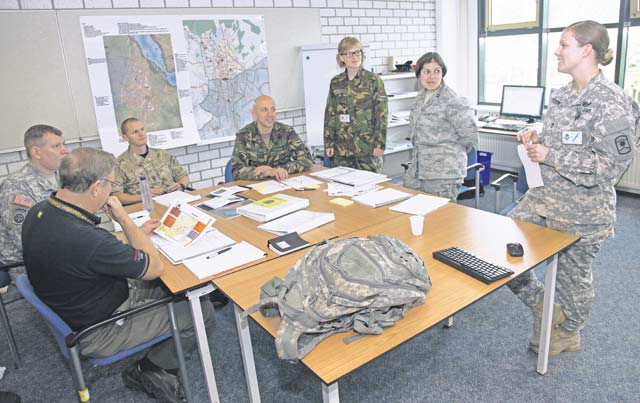
THE HAGUE, Netherlands — Three Army Reserve Soldiers from the 361st Civil Affairs Brigade, 7th Civil Support Command, 21st Theater Sustainment Command participated in a NATO-accredited Civil-Military Cooperation Centre of Excellence field worker course Sept. 15 to 26.
“The branch ‘training and education’ is responsible for the development of NATO civil-military cooperation training and also support of exercises on civil-military cooperation,” said Netherlands army Capt. Stephanie Groothedde, staff officer assigned to the Training and Education Branch, CCOE.
This was the first CCOE course held at the new facility in The Hague after moving from Enschede, Netherlands, this year.
“Each NATO country has their own aspect of CIMIC,” said U.S. Army Sgt. 1st Class Maria Pitrone, training NCO assigned to D Company, 457th Civil Affairs Battalion, 361st CA Bde. “In the United States Army we call it civil affairs. There isn’t a large difference between CIMIC and civil affairs. The biggest difference is doctrine and the mandate that CIMIC has.”
Pitrone was the syndicate coach for six service members and one civilian during the field worker course.
“It is nice to be able to learn from the different nations, their cultures and their humanitarian procedures,” said British army Warrant Officer Class 2 Chris Parsons, Military Stabilization Support Group. “The CCOE is a group of people from different nations who have a lot of experience in CIMIC.”
The two concurrent CCOE classes were the CIMIC field worker and CIMIC staff worker courses, which had service members and civilians from 10 different nations, including the Netherlands, Turkey, Hungary, the U.S. and the United Kingdom, as well as guest lecturers.
“Interactions have been fantastic,” Parsons said.
The CIMIC classes addressed how to work with, engage, restart and mentor local populations and governments in the aftermath of war and natural or man-made disasters during foreign consequence management missions.
“In week one, we did a lot of slideshow presentations and we brought all of the students together,” Pitrone said.
In week two, the students did a final exercise, Pitrone said. They operated their own CIMIC Centre in a simulated country.
Pitrone described the CIMIC Centre as a place for liaison and coordination with other agencies that maybe in the post war torn or disaster area to come together and to coordinate military and humanitarian assistance in that area.
“My role here at the CCOE is as a syndicate coach,” Pitrone said. “There are two different field worker syndicates, and I help guide one of the syndicates (through their operations).”
Pitrone played a key role, Groothedde said.
“Sergeant Pitrone is a very experienced civil affairs NCO and therefore is a great contribution to this course,” Groothedde said. “Her interaction with the students and the fellow instructors is very positive and she’s able share some of her experience in civil affairs into the CIMIC course.”
The CCOE is the training center for all NATO CIMIC officers and enlisted personnel, Pitrone said.
“This is a great opportunity to be able to work with our NATO nations and our partners,” Pitrone said.
CIMIC personnel can learn to work together before a disaster, she added.
Each nation has a center of excellence but in a different specialty, Pitrone said. However, this is the only CIMIC COE schoolhouse.
“We have developed different courses on different levels, and we are also teaching those courses here at the CIMIC Centre of Excellence and also at other locations abroad,” Groothedde said.
Parsons said he recommends anyone interested in CIMIC attend future courses.
“It is good to learn from them and their real-world CIMIC experiences,” he said.


